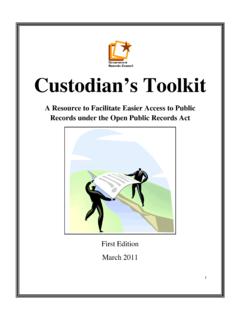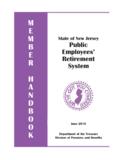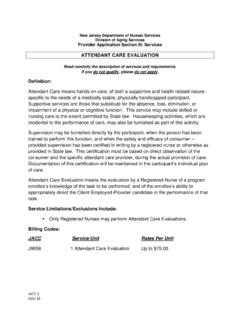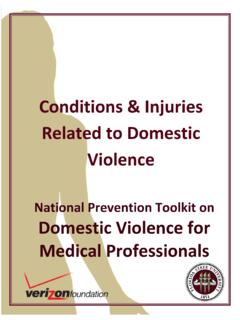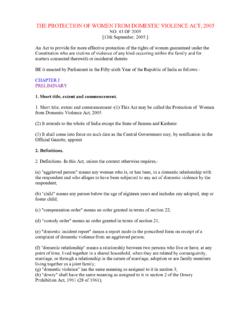Transcription of Legal Aspects Of Domestic Violence
1 New Jersey Division of Criminal Justice Legal Aspects Of Domestic Violence Student Manual Instructor Note Note: This training module is for law enforcement use only. It is intended to serve as a summary of Legal concepts. It does not constitute the creation of a prescribed Legal standard. It should not be construed as evidential in any criminal or civil proceedings. As with all training material that is date sensitive, the instructor should ensure that the most current training material is being used. The Division of Criminal Justice has prepared the following Domestic Violence training programs, with both instructor and student manuals: Dynamics of Domestic Violence , Module 1. Legal Aspects of Domestic Violence , Module 2. Enforcement of Out-of-State Restraining Orders or Orders of Protection in Domestic Violence Cases, Module 3.
2 Interviewing Techniques in Domestic Violence Cases, Module 4. Handling a Domestic Violence Call, In-Service Training for Police Dispatchers Training Guide for Completing the Victim Notification Form u Training Guide for Completing the Domestic Violence Complaint and Application for a Temporary Restraining Order Table of Contents Introduction to the Legal Aspects of Domestic Violence 1. Who is a Victim of Domestic Violence 1. Criminal Offenses Which Constitute Domestic Violence 5. Arrest 8. Completing the Criminal Complaint 12. Seizure of Weapons .. 13. Response to Domestic Violence Incident . 17. Procedure for the Victim to Obtain a Temporary Restraining Order 19. Service of a Temporary Restraining Order 20. Procedure for the Victim to File a Criminal Complaint 21.
3 Procedure for Victim to File Both a Criminal Complaint & a Domestic Violence Complaint ..22. Obtaining a Temporary Restraining Order Through the Police Department 22. Court Order Violations (contempt) 23. Police Reports 25. Fingerprinting the Defendant .26. Police Liability ..26. Services Available for victims and Batterers 27. Case Studies 27. Notes I. Introduction to the Legal Aspects of Domestic Violence This session will focus on the laws of Domestic Violence . It is important that law enforcement officers understand the Legal Aspects of Domestic Violence and their relationship to the criminal offenses in the State's penal code. Domestic Violence is a very serious problem. It is a crime. Domestic Violence is responsible for more injuries to women that any other reason, exceeding injuries due to rape, mugging, and traffic accidents combined.
4 In some cases, battering escalates to homicide and suicide. Law enforcement officers are charged with the duty of enforcing the laws. Law enforcement officers have an opportunity to stop the escalation of Violence in the home. By enforcing the Domestic Violence laws, the officer provides the most effective deterrent to future abuse. Domestic Violence is a learned behavior. About 85% of all abusive partners were battered as children or witnessed assaults on their mothers. Children also are victims of abuse in half of the families in which the mother is abused. By enforcing the Domestic Violence laws, the officer may reduce the Violence in the streets. II. Who is a Victim of Domestic Violence ? Definitions Reference: 2C:25-19 Procedures covered in this instructional unit are based on the 3 Note: The provisions of the Domestic Violence laws should Attorney General's be liberally construed by the law enforcement officer in Guidelines on Police favor of action protecting a victim of Domestic Violence .
5 If Response Procedures in an officer is in doubt as to whether or not a person meets the Domestic Violence criteria for being a victim of Domestic Violence , the officer Cases should contact the supervising officer, the department's Legal advisor or the on-call judge in accordance with departmental procedure. A. Victim of Domestic Violence means a person protected under Review Handout 1: this act and includes any person Flow Chart for Identifying victims of Domestic Violence 1. a. who is 18 years of age or older, or Division of Criminal Justice Training Module Rev. 6/03. 2 - 1. Notes b. who is an emancipated minor, and 3 Note: A minor under the age of 18 may not be considered a victim of Domestic Violence but may be a victim of a criminal offense.
6 The officer should consider whether any criminal law was violated and take the appropriate action. 2. who has been subjected to Domestic Violence by a. spouse b. former spouse c. any other person who is a present or former household member, or d. any person with whom the victim has had a dating relationship, or e. any person whom the victim anticipates having a child in common because the victim or abuser is pregnant Or 3. Anyone who, regardless of age, has been subjected to Domestic Violence by a person: a. with whom the victim has a child in common, or b. with whom the victim anticipates having a child in common, because the victim or abuser is pregnant. Or 4. Anyone who, regardless of age, has been subjected to Domestic Violence by a person with whom the victim has had a dating relationship.
7 B. Household Member Defined. This determination of whether a person is or was a household member should be liberally construed by the police officer. In some cases, the dating relationship category will apply and the officer will not have to consider this category. Division of Criminal Justice Training Module Rev. 6/03. 2 - 2. Notes In determining whether a person is a former household member, the officer should consider the length of time since the two persons resided together as well as other relevant factors. If an officer is in doubt as to whether or not a person meets this definition of a household member, the officer should contact the supervising officer, the department's Legal advisor or the on-call judge. C. Emancipation Defined A minor is considered emancipated from his or her parents when the minor: has been married, has entered military service, has a child or is pregnant, or has been previously declared by a court or an administrative agency to be emancipated.
8 D. Dating Relationship Defined. 1. A victim of a dating relationship may be below the age of 18. 2. The Domestic Violence assailant must be over the age of 18 or emancipated at the time of the offense. 3. The New Jersey law does not list any criteria by which an officer can determine what is and what is not a dating relationship. This provision should be liberally construed. If the officer is in doubt about a particular relationship, the officer should review the matter with the officer's supervisor, the department's Legal advisor or the on-call judge. To assist the supervisor, Legal advisor or judge in making this determination, the officer should obtain such information as: the length of time of the relationship Division of Criminal Justice Training Module Rev.
9 6/03. 2 - 3. Notes the type of relationship the frequency of interaction between the parties, and if the relationship has been terminated by either person, the length of time elapsed since the termination of the relationship. 4. Domestic Violence is not limited just to persons who share or who shared a household. Dating and courtship can result in injuries, and at times, death. A Massachusetts study showed that of females between the ages of 15-19 that died as a result of homicide, 30%. were murdered by boyfriends or ex-boyfriends. This the same percentage as for adult female homicide victims by a husband or boyfriend or ex. 1. Teen dating relationships have much in common with adult relationships. In neither case is Violence limited to any particular socioeconomic class, ethnic group, or In many cases, adult victims of Domestic abuse indicate that they first experienced such Violence while they were still in their Factors common to Violence in both adult and teen dating relationships are jealously, control, threats, physical Violence , and sexual Violence .
10 Teenage abusers, like adult abusers, used intimidation, making frightening gestures, smash objects, drive dangerously, and kidnap or harm pets to obtain compliance4 from the victim.. Persons committing dating Violence are more likely to use objects or criminal weapons during the abuse than those involved in marital Although persons involved in a dating relationship do not normally reside together, a victim in a dating relationship can feel equally trapped in an abusive relationship, as does a victim in a marital relationship. The teenage abuser's threats of revenge can be just as frightening as an adult batterer's threats. victims in a dating relationship also can be as emotionally and socially dependent on their abusers as are married E. Elderly Abuse & Neglect Division of Criminal Justice Training Module Rev.
